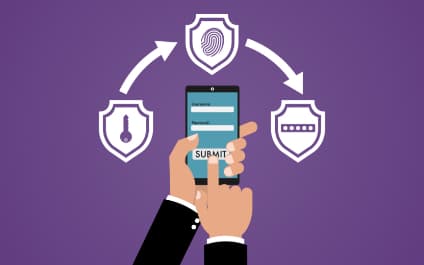
The Ultimate Guide to Understanding Multi-Factor Authentication
It’s possible you’ve used a multi-factor authentication system before without ever even knowing it. Think about the last time you logged into Facebook. You entered your password—probably correctly on the first try, right?—and were immediately prompted to type in a set of numbers that was sent directly to your cell phone.
You glance down at your phone, see a flash of numbers pop up, you enter them, and viola—you’re in.
You might not have thought a thing of it—or you might have thought, “hmm, that’s a little annoying, but it’s definitely more secure.” No matter what you thought, if you considered it any further, or it never crossed your mind again (until right this very moment as you read this article), you just experienced a multi-factor authentication process.
Neat, right?
While it’s definitely cool that technology can work in conjunction that way, this is far more than just a neat little feature—in fact, it’s an incredibly important security measure that’s more than crucial for modern-day businesses.
Over the past few years, businesses have been going entirely digital—nowadays, there’s a mass exodus of industries switching over to cloud-based systems (for space, security, and modernity purposes, among others). While storing valuable, private, and intimate information on a computer or in a cloud system certainly helps with space issues (and with keeping modern-day businesses up to date with the latest technology), it absolutely presents us with a new set of challenges—hackers.
With the ever-swelling wave of cybercrime consistently crashing down on businesses, it’s of vital importance that companies who are storing their valuable data and credentials online are doing everything they can to protect it.
That’s where Multi-Factor Authentication(MFA) comes in—and even better, that’s where we come in, too. (https://www.ybs.us/)
What Exactly is Multi-Factor Authentication (MFA)?
An MFA—the shortened version of the term multi-factor authentication—is simply a security system that requires that you (the user who is trying to access valuable files, data, or information) enter in more than one method of authentication.
Before we dive into what that means exactly, let’s briefly talk about what authentication really means.
Authentication factors are the credentials a user inserts in order to verify who they are and that they’re able to access the files, documents, data, and more that they’re attempting to view. In other words, your authentication factor—your password, your pin-code, your security question—is your security system saying to you “you know this answer, so you are who you say you are.”
Obviously, that authentication factor isn’t going to be common knowledge (not intentionally, anyway)—it will go to only those who need it to gain access to sensitive information. It’s secure. It’s a barrier that you have to breach to get to that private information.
In the simplest terms, it’s a layer of protection for your sensitive information.
A multi-factor authentication system is a clever combination of several (typically 2) independent authentication factors that act as a credential to better protect private information. In other words, it’s creating an additional layer of protection in the security system.
Consider this scenario.
A hacker or cybercriminal manages to figure out what your company password is. In a single authentication factor system (where the password is the only credential required to log in), they’ve cracked the code. They’re in, they have your info, and you’re out of luck.
But, consider how this scenario would go down with a Multi-Factor Authentication or 2FA system. The hacker acquires the password. They type it in. It works—but does it? They’re prompted to enter the code sent to the linked cellphone. Obviously, they’re not receiving a text anytime soon.
What could have been a disastrous and catastrophic event for your business was cleverly avoided by implementing a simple Multi-Factor Authentication (MFA) security system.
Sure, it might be a bit pesky and annoying to enter in two forms of credentials or authentication—but in the long run, every extra step means better protection for you and your business.
How Does Multi-Factor Authentication Work: What Does it Look Like?
Remember our Facebook example at the beginning of this article? That was a simplified example of Multi-Factor Authentication (MFA)—but nevertheless, an accurate one.
There can be any number of MFA combinations and scenarios, but there are a few common ones that work like a dream—you might already be familiar with a few of these.
- Entering a pin and then swiping an ID card that’s been distributed to you.
- Scanning a fingerprint and then entering a password.
- Entering a password and then answering a unique security question.
- Entering a password and waiting to receive a one-time pin (which changes every time you log in) via phone or email.
Why Does Multi-Factor Authentication Matter?
While we could talk endlessly about why Multi-Factor Authentication (MFA) matters (in fact, we do in this blog post, here), we’ll keep it short and sweet this time.
- Multi-Factor Authentication combats identity theft—which, is a low-risk and high-reward type of cybercrime (as well as the fastest-growing type of crime, too!)
- Malicious cybercriminals are advancing their technology every single day—from 2013 to 2014, the level of successful hacking breaches increased by about 27.5 percent—that number just continues to get bigger. With MFA, you’re throwing more troublesome roadblocks in their way, diminishing your risk.
- It helps both big and small businesses! While you might think this just affects those household-name businesses, about 31 percent of online targeted (https://www.symantec.com/security-center/threat-report) attacks are aimed at establishments with 250 employees and less.
- Multi-Factor Authentication protects you from hackers who are looking to destroy your data, steal it, change programs, send out spam, and wreck your business.
- It can help monitor your systems both internally and externally.
At Your Business Solutions, not a day goes by that we don’t recommend and insist our clients choose Multi-factor Authentication (MFA) security systems for their businesses. Why? Because every extra measure that we can help customers take to protect their valuable information (as well as their business’ welfare) is important to us. MFA, even if you find it a bit pesky at times, is wildly helpful. We believe that Multi-Factor Authentication is more than just a useful tool, it’s the future of the password, and with it, we can help you guarantee you and your business are protected.

